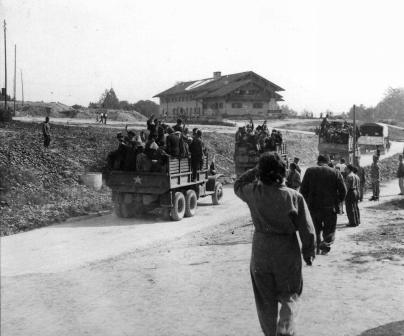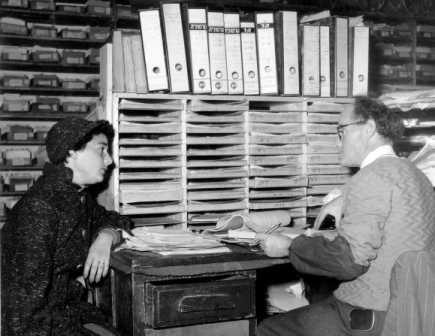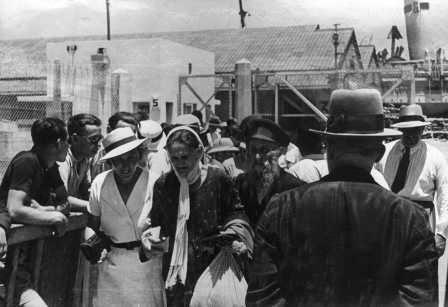 "Each wave of persecution, each new Nazi military victory, uprooted many Jews and turned them into refugees overnight. Heartbreaking, panic-stricken letters began to pour, indeed flood, into the offices of the Jewish Agency, telling of lost sons, of brothers that had left for Palestine by ship in the dead of night, of parents that had abandoned their home in search of a safe haven, all of whose tracks had been lost. No one knows - have they arrived at their destination? Are the safe?" (From a report of the Search Bureau for Missing Relatives to the 1964 Zionist Congress).
"Each wave of persecution, each new Nazi military victory, uprooted many Jews and turned them into refugees overnight. Heartbreaking, panic-stricken letters began to pour, indeed flood, into the offices of the Jewish Agency, telling of lost sons, of brothers that had left for Palestine by ship in the dead of night, of parents that had abandoned their home in search of a safe haven, all of whose tracks had been lost. No one knows - have they arrived at their destination? Are the safe?" (From a report of the Search Bureau for Missing Relatives to the 1964 Zionist Congress).
Many families were split up during World War II. After the War, these people were in need of a place where they could seek assistance and begin the search for their missing relatives. Jewish relief agencies ceased to function during the War, and so the Jewish Agency became the main organization that dealt with these requests.
 After the fall of the Nazis in 1945, the Jewish Agency founded the Search Bureau for Missing Relatives. Branches of the Bureau were opened in Jerusalem, Tel Aviv and Haifa. At first, lists of names of refugees were published in the daily newspapers, but due to the high demand, the Search Bureau soon started to publish its own weekly, named Lakarov Ulerahok ("To the Near and Far"), that dealt solely with the task of publishing refugees' names, as well as messages to missing relatives. Aside from data regarding incoming refugees, the paper also published information regarding the remaining Jewish diaspora in territories previously under Nazi occupation.
After the fall of the Nazis in 1945, the Jewish Agency founded the Search Bureau for Missing Relatives. Branches of the Bureau were opened in Jerusalem, Tel Aviv and Haifa. At first, lists of names of refugees were published in the daily newspapers, but due to the high demand, the Search Bureau soon started to publish its own weekly, named Lakarov Ulerahok ("To the Near and Far"), that dealt solely with the task of publishing refugees' names, as well as messages to missing relatives. Aside from data regarding incoming refugees, the paper also published information regarding the remaining Jewish diaspora in territories previously under Nazi occupation.
The radio, recognizing the importance of this endeavor, started to broadcast the messages that appeared in the paper. The published lists of refugees were also broadcast, first in "Kol Yerushalayim" ("Voice of Jerusalem"), later to become "Kol Yisrael" ("Voice of Israel"), the Israeli state radio, and later in "Kol Zion LeGolah" ("Voice of Zion to the Diaspora") – a station broadcasting abroad in Hebrew and Yiddish – in order to reach as wide an audience as possible. These weekly broadcasts became an important event, with entire families huddled around the radio with the hope of hearing a familiar name.
 A copy of the Search Bureau's weekly, "To the Near and Far", is kept in the Central Zionist Archives. It was published from July 1945 until September 1947, a total of 63 issues that comprised of more than 180,000 names of Holocaust survivors. According to the Search Bureau's report to the 1946 Zionist Congress, over 30,000 Jews residing in Palestine reunited with their relatives as a result of the Search Bureau's activities, and 60,000 survivors contacted their relatives living here.
A copy of the Search Bureau's weekly, "To the Near and Far", is kept in the Central Zionist Archives. It was published from July 1945 until September 1947, a total of 63 issues that comprised of more than 180,000 names of Holocaust survivors. According to the Search Bureau's report to the 1946 Zionist Congress, over 30,000 Jews residing in Palestine reunited with their relatives as a result of the Search Bureau's activities, and 60,000 survivors contacted their relatives living here.
A few years after the War, the search for lost Holocaust survivors became less central in the activity of the Jewish Agency, and other search endeavors took the lead, such as the task of reuniting new immigrants to Israel with their family members.